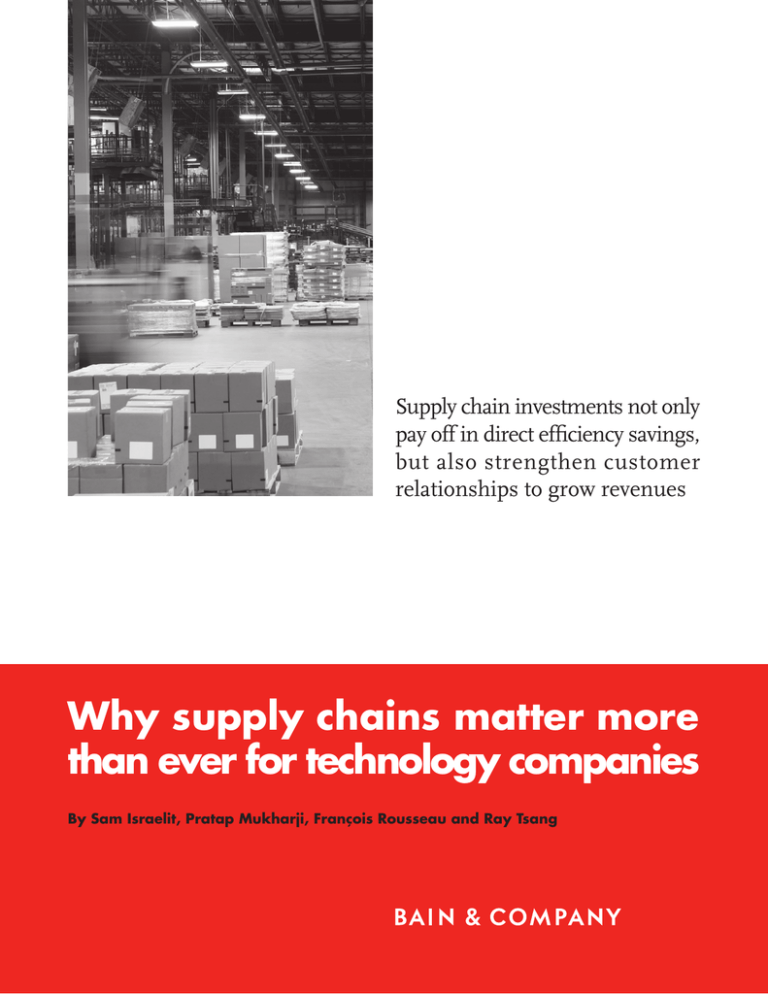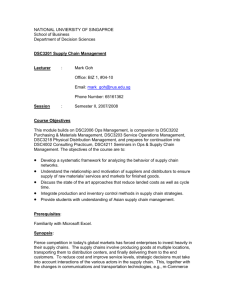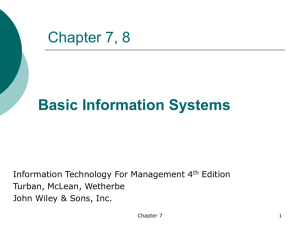
Supply chain investments not only
pay off in direct efficiency savings,
but also strengthen customer
relationships to grow revenues
Why supply chains matter more
than ever for technology companies
By Sam Israelit, Pratap Mukharji, François Rousseau and Ray Tsang
Sam Israelit is a partner in Bain & Company’s San Francisco office. Pratap
Mukharji is a Bain partner in Atlanta. François Rousseau is a partner in Paris.
Ray Tsang is a partner in Shanghai.
Copyright © 2011 Bain & Company, Inc. All rights reserved.
Content: Global Editorial
Layout: Global Design
Why supply chains matter more than ever for technology companies
Supply chain investments
not only pay off in direct
efficiency savings, but
also strengthen customer relationships to
grow revenues.
There’s a good reason why supply chain efficiency
has never been a major priority for technology
companies. As part of a rapidly growing and
evolving industry, companies pursued—and
reached—ambitious growth goals by aggressively
delivering platform innovations and increasingly
sophisticated products. But as many technology
segments started maturing, rampant SKU proliferation resulted in supply chain complexity
and an inability to effectively manage the operations. Then, when industry-wide growth ultimately
slowed, companies were faced with rising costs,
which were growing faster than revenues. A
maturing market also meant that supply chains
were becoming an increasing point of competitive
differentiation, and customers were quick to
shift their purchase volumes to those companies
that could deliver reliably.
Now, late to the game, many technology companies have begun looking at their supply chains
in earnest. They see supply chain efficiency
as a way to manage costs in order to improve
margins. More important, leaders now realize
that, because customers increasingly care about
response times and supply assurance—and are
demanding scheduling accuracy and flexibility—
the effectiveness of a company’s supply chains
can help it lock in key strategic accounts.
But when companies assess the state of their
supply chains, too often they are disappointed
by what they see.
To understand how technology companies stack
up, we conducted an in-depth analysis of the
supply chains at six leading technology companies.
We found a wide disparity in both the efficiency
and effectiveness of their operations. We also
found that these companies lacked the supply
chain sophistication of their counterparts in
more mature industries. For example, at the
technology companies we analyzed, supply
chain data typically is so poorly tracked that only
two of the six companies were able to provide
either a comprehensive or a product segment
list of supply chain costs. By contrast, such
capabilities are common among consumer
products and retail companies.
Lacking basic information is one clear sign that
a technology company falls short of achieving
its full supply chain potential. Several additional
signs are:
•
The company operates a single, undifferentiated supply chain offering across a range
of customer and product types.
•
The company lacks clear supply chain targets,
and even when targets are in place, there are
no specific incentives associated with supply
chain performance.
•
The company can’t identify the executive
ultimately in charge of the supply chain.
Governance and accountability are fragmented and unclear across the organization.
•
There is no formalized integration between
demand and supply planning—the Sales
& Operations Planning (S&OP) process is
not effective or is not used.
•
The company lacks integrated systems and
automation. So its processes, such as S&OP,
include a number of inefficient manual
touchpoints and inconsistent baseline data.
•
Finally, the company is not meeting the supply
chain needs of its most important customers.
Based on our work with technology companies,
we’ve identified the three most important areas
for improvement:
1
Why supply chains matter more than ever for technology companies
1. Capture actionable data to support critical decisions
Companies need to track key performance
metrics for their overall supply chain, as well
as for key business segments, while ensuring
that data is easily accessible through a single
integrated system (see Figure 1). The trouble
is that most technology supply chains simply
don’t include sophisticated data capture and
management systems.
Among the companies participating in our survey, the difficult benchmarking process typically
requires more than five individuals and two to
seven weeks to extract and provide key data.
Despite IT advances, many supply chains still
run poorly integrated legacy systems. There
may be disparate systems for demand planning, supply planning, manufacturing and
warehousing—with a variety of spreadsheets
required to move and analyze data.
When supply chain metrics are tracked, they’re
often lacking two dimensions. Many metrics may
be tracked for specific parts of the organization
but not consolidated into a view of the total supply
chain costs for the company. Also, while many
companies conduct customer-level tracking to
comply with service-level agreements, they have
limited ability to aggregate the data and differentiate performance and cost-to-serve for
different business segments.
To see what works, consider how supply chain
metrics typically are tracked in the fast-moving
consumer goods (FMCG) industry, which has
developed well-honed systems—processes and
technology—for tracking data to help executives
make better decisions. Decision makers for consumer products companies often have ready
access to key supply chain data—an overall supply
chain view of costs including people, warehousing, freight and other factors. They can break down
costs by segment, if not by unit, which facilitates
cost management and service trade-off discussions.
Figure 1: Example of a technology company’s supply chain dashboard
Metric
Status
Target
Current
month
Prior
month
Year
ago
X%
X%
X%
X%
John D.
X%
X%
X%
X%
Andy J.
X%
X%
X%
X%
Amy C.
Owner
Supply chain costs (percent of revenue)
+ Headcount
+ Distribution
+ Freight
+ Indirect
+ Total
+ Inventory turns
X%
X%
X%
X%
Jen F.
X%
X%
X%
X%
John D.
X
X
X
X
Ben F.
X%
X%
X%
X%
Jim J.
X%
X%
X%
X%
Mark K.
X
X
X
X
John S.
X
X
X
X
Jane D.
X
X
X
X
Jane D.
Quality
+ Perfect order
+ Net Promoter® score
Speed
+ Planning cycle time
+ Manufacturing cycle time
+ Ordercash cycle time
+ Drill down for details by product, geography or overtime
2
On track
Warning
Off track
Why supply chains matter more than ever for technology companies
2. Segment your customers and
products to define differentiated
service offerings
serve customers. The same customer can receive a different level of service for different
product categories.
Technology companies lose a tremendous opportunity by not segmenting their offerings based
on product type and customer importance. The
goal is to provide better service to higher-priority
customers or product segments. Companies
can’t offer their best service to every customer
or for every product.
When it comes to creating a fulfillment model,
higher-priority customers can be served through
consignment or vendor-managed inventory,
resulting in a higher level of service. For customers
who buy standard products on a relatively predictable schedule, inventory can be reserved—
rather than pooled with products that will be
distributed to other customers whose demand is
not as stable. For lower-priority customers and
for low-volume products with less predictable
demand, distributors can serve as aggregators
of customers or of product demand.
Even though technology companies have for
years understood the value of segmenting, few
have succeeded in making the most of these
opportunities to cater to customers based on
their diverse needs. Different customers have
different requirements for cost, availability
and speed. It’s not effective for suppliers to
provide the same high-level service to everyone—which is what they usually try to do today.
The resulting costs are high, and that level
of performance is not necessary for many of
their customers.
Leading companies use customer tiering to
determine the appropriate fulfillment model
and customer service target, breaking customers
into three to five groups based on the current
revenues they generate and their potential for
future revenues. To determine the best fulfillment mode, companies apply a similar tiering
model to their products, segmenting according
to the level of volume or margin, or by whether
they are new, mainstream or end-of-life. Like
customers, different products also have diverse
needs for cost, availability and speed. Highermargin products are less sensitive to cost fluctuations but are more sensitive to missing a
potential sale. Lower-margin products may be
more sensitive to cost increases and, in some
cases, less sensitive to availability delays.
Based on the results of their segmenting efforts,
companies use three approaches to differentially
Companies can take advantage of service-level
tiering by creating three or four levels of service
based on customer priority. For example, top
customers can have flexible lead times, better
delivery performance and multiple shipping
methods. Lower-priority customers will face
more rigid lead times, lower delivery performance and limited shipping options.
Customer support can be similarly segmented.
For top-priority customers, provide personalized
support, supplying direct lines for executives
seeking customer service and offering them
preference when allocation issues arise. Some
companies reserve extra stock to support higherpriority customers or pull inventory back from
distributors when supply is constrained. On
the other hand, lower-priority customers receive low-touch—or even no-touch—customer
support. In some cases, the majority of communication may be from a distributor, not the
manufacturer, or through Electronic Data
Interchange (EDI)—with support limited to
extraordinary circumstances.
Successful segmentation requires multiple
process and delivery options to serve the different segments. For example, low-margin products
3
Why supply chains matter more than ever for technology companies
may call for lower-touch supply chain options
to ensure profitability. High-volume, low-margin
products may use automated pathways and
direct-to-customer logistics. High-margin products
may have higher priorities in the production
cycle to ensure that a sale is never missed.
It’s important to be able to provide high- and
low-touch supply chain options without creating
multiple separate supply chains—and the resulting complexity. Leaders develop different pathways
through their supply network to enable flexibility, managing the overall organization centrally
to maintain control.
3. Establish operational excellence
throughout the organization
Once your company establishes the infrastructure
to generate and track data and the processes
for a segmented offering, you can use standard
supply chain tools to make incremental, but
significant, improvements.
Manage the cost base by focusing on optimizing
inventory, driving down cycle times and achieving the efficiencies gained through experience
and scale.
For example, use statistical safety stock rather
than heuristics to establish target inventory
levels. Many technology companies still use
weeks-of-sales metrics to manage their inventory. They’re not adjusting their inventory to
consider all the factors that affect the need for
buffers, such as demand variability, manufacturing and materials lead-time variability, or
required service levels. A weeks-of-sales metric
does not account for these variables, but companies often apply it across a wide range of products
and customers because it is easy to calculate. A
manufacturer might need very little safety stock
for a product with stable demand and lead time,
but a product with a volatile lead time and unstable demand will require a much higher safety
stock to meet service-level targets.
Improve forecasting by leveraging best practices,
performing more advanced historical analysis
(such as diffusion modeling) and upgrading
systems. Technology products have much higher demand volatility and shorter life cycles than
more stable consumer products, which may be
available in stores for many years. Because this
places a lot of stress on the supply chain, any
efforts to improve forecasting accuracy will pay
huge dividends in both higher availability and
lower costs.
Drive down cycle time in manufacturing, materials and planning. Cycle time in semiconductor
manufacturing, for example, is particularly
long, especially given the lead times for key
raw materials. Efforts to eliminate unnecessary
touchpoints, hold times or planning delays
can have a significant impact on increasing
supply responsiveness.
The competitive landscape in the technology
sector won’t get any easier in the foreseeable
future. Focusing on supply chain performance
can provide a strategic advantage, helping bring
products to market faster, at the right service
levels and in a cost-effective way. Done right,
the trade-offs among cost, speed and availability will balance real benefits with incremental
costs and potential risks, and ensure that investments are carefully scrutinized for a good
return on investment. Decisions must be made
based on a solid fact base, incorporating both
internal data and external benchmarks. By applying these concepts, supply chain professionals
will address many of the challenges they face
and put their companies on the path to supply
chain leadership.
Net Promoter® and NPS® are registered trademarks of Bain & Company, Inc., Fred Reichheld and Satmetrix Systems, Inc.
4
Bain’s business is helping make companies more valuable.
Founded in 1973 on the principle that consultants must measure their success in terms
of their clients’ financial results, Bain works with top management teams to beat competitors
and generate substantial, lasting financial impact. Our clients have historically outperformed
the stock market by 4:1.
Who we work with
Our clients are typically bold, ambitious business leaders. They have the talent, the will
and the open-mindedness required to succeed. They are not satisfied with the status quo.
What we do
We help companies find where to make their money, make more of it faster and sustain
its growth longer. We help management make the big decisions: on strategy, operations,
technology, mergers and acquisitions and organization. Where appropriate, we work with
them to make it happen.
How we do it
We realize that helping an organization change requires more than just a recommendation.
So we try to put ourselves in our clients’ shoes and focus on practical actions.
For more information, please visit www.bain.com








